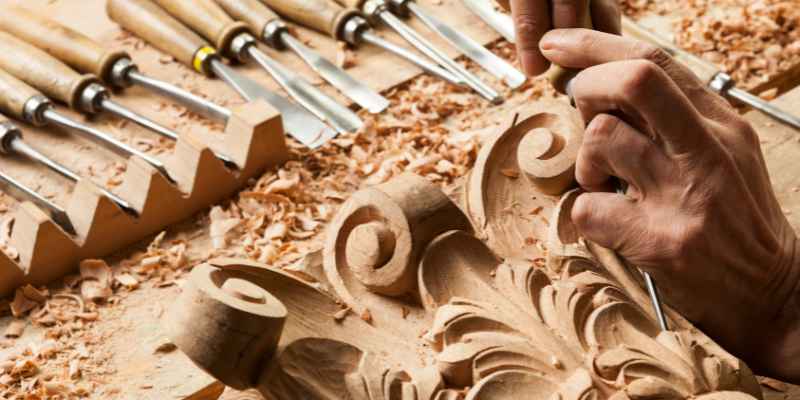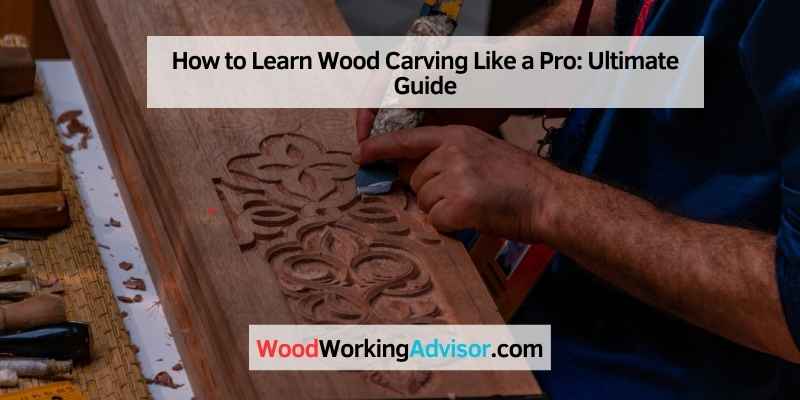To learn wood carving, start with basic techniques like carving with the grain and making push and pull cuts. It’s crucial to begin with simple projects and gradually progress to more complex designs.
Learning to carve wood may take a couple of weeks to several months, depending on the effort you put into practicing. Wood carving requires patience, practice, and dedication, as it’s not an easy skill to master. This craft demands a steady hand and keen attention to detail, making it both mentally and physically challenging.
However, with consistent effort, you can create beautiful pieces of art for yourself or others. Wood carving is a timeless craft that allows you to transform a simple piece of wood into intricate works of art. Whether you’re a beginner fascinated by the idea of creating wooden sculptures or an experienced woodworker looking to enhance their skills, learning wood carving can be a fulfilling and rewarding journey.
The process of learning how to carve wood involves understanding the basic techniques, honing your skills, and gradually mastering the art of shaping wood into beautiful creations. With the right guidance, tools, and patience, anyone can learn the art of wood carving and unleash their creativity through this ancient craft.
Getting Started With Wood Carving
Getting started with wood carving is an exciting journey that allows you to unleash your creativity and create stunning pieces of art. Whether you are interested in relief carving, carving intricate designs, or sculpting, wood carving offers a diverse range of techniques to master.
Essential Tools For Wood Carving
When starting your wood carving journey, it’s crucial to have the right tools. Here are some essential tools you should consider:
- Carving gouges
- Chisels
- Wood carving knives
- Carving mallet
- Sandpaper
Basic Safety Measures
Prioritize your safety when engaging in wood carving. Here are basic safety measures to adhere to:
-
- Always wear carving gloves to protect your hands.
- Learn proper knife handling techniques to avoid accidents.
- Keep your tools sharp to prevent slips and mishaps.
- Work in a well-ventilated area to avoid inhaling wood dust.
Understanding Wood Carving Techniques
Wood carving is a timeless craft that requires precision, patience, and creativity. To begin mastering the art of wood carving, it is crucial to understand various techniques that will help bring your visions to life. From carving with the grain to creating intricate designs, each technique contributes to the overall mastery of wood carving.
Carving With The Grain
Carving with the grain is a fundamental technique in wood carving. Working with the natural direction of the wood fibers ensures smoother cuts and minimizes the risk of splintering or damaging the piece. By understanding the grain pattern and aligning your cuts accordingly, you can enhance the overall quality of your wood carving projects.
Creating Intricate Designs
Crafting intricate designs requires a combination of skill and creativity. Whether you are working on relief carvings, sculptures, or decorative pieces, attention to detail is crucial. Utilizing specialized carving tools and mastering techniques such as undercutting and chip carving allows for the creation of intricate and captivating designs that showcase your expertise in wood carving.
Top Tips For Beginners
Learning wood carving may seem daunting at first, but with the right approach and a few helpful tips, you’ll be well on your way to mastering this ancient art. Whether you’re a complete beginner or have some experience with woodworking, these top tips will help you navigate the world of wood carving and create impressive pieces of art. Let’s dive in!
Starting At A Suitable Level
When you’re just starting out with wood carving, it’s important to begin at a suitable level that matches your skill and experience. Starting with simple projects allows you to practice fundamental techniques and build confidence before tackling more complex designs. By gradually progressing from basic to advanced projects, you’ll develop a strong foundation and enhance your carving skills.
Developing Your Own Style
Wood carving is not just about following patterns and replicating designs. It’s an opportunity to express your creativity and develop your own unique style. As a beginner, it’s essential to experiment with different carving techniques, explore various wood types, and find what works best for you. Don’t be afraid to take inspiration from other carvers but strive to develop a style that sets your pieces apart and reflects your artistic vision.
Here are a few tips to help you develop your own style:
- Study the works of different wood carvers to gain inspiration and learn new techniques.
- Experiment with different types of wood to understand their characteristics and how they affect your carvings.
- Seek advice and feedback from experienced carvers to learn from their expertise and incorporate their suggestions into your work.
- Practice regularly and keep pushing yourself to try new techniques and designs.
By dedicating time and effort to developing your own style, you’ll create wood carvings that are truly unique and reflect your artistic journey.
Wood carving is a traditional craft that requires patience, practice, and dedication. As a beginner, remember to relax and enjoy the process. Don’t be too hard on yourself when mistakes happen. Embrace them as learning opportunities and a chance to improve your skills. With time and practice, you’ll see significant progress and be proud of the beautiful pieces of art you can create.
Mastering The Craft
Embark on the journey of mastering the craft of wood carving with essential techniques like carving with the grain and using the V-gouge tool. Start with simple projects and progress steadily towards creating intricate designs. Develop your unique style and enjoy the art of wood carving.
Practice Makes Perfect
Repetition strengthens your skill in wood carving. Practice regularly to improve your technique. Embrace mistakes to learn and grow.
Time Required To Learn Wood Carving
Learning wood carving demands dedication. Invest ample time to master this craft. Patience is key to honing your skills.
Challenges In Wood Carving
Wood carving is an intricate art form that requires precision, skill, and creativity. However, like any other craft, it comes with its fair share of challenges. Overcoming these challenges is what makes wood carving a rewarding and fulfilling hobby. In this section, we will explore two key challenges that wood carvers often encounter: patience and persistence, and the difficulty level of wood carving.
Patience And Persistence
Patience and persistence are virtues that every wood carver must cultivate. Wood carving is a meticulous process that demands attention to detail and a steady hand. It can be frustrating at times, especially when mistakes happen or the desired results are not met. However, by practicing patience and staying persistent, you can overcome these obstacles and continue to improve your skills.
Difficulty Level Of Wood Carving
Wood carving is not an easy craft to master. It requires a combination of technical skills, artistic vision, and knowledge of wood properties. The difficulty level varies depending on the complexity of the design and the type of wood being used. Some woods are harder to carve than others, requiring additional tools and techniques. Beginners may find certain carving styles or intricate patterns more challenging to execute.
Additional Resources For Wood Carvers

If you are looking to enhance your wood carving skills, there are various resources available that can provide valuable insights and guidance. From the best wood types for beginners to expert advice on improving carving techniques, these additional resources can help you on your wood carving journey.
Best Wood Types For Beginners
When starting out with wood carving, it is essential to choose the right type of wood that is easy to work with and suitable for beginners. Some of the best wood types for beginners include:
- Basswood: Known for its softness and fine grain, making it ideal for intricate carving.
- Pine: Easy to carve and readily available, great for practicing basic carving techniques.
- Butternut: Offers a smooth texture and is easy to carve, perfect for beginners.
Expert Advice For Improving Carving Skills
Seeking expert advice can greatly benefit wood carvers looking to improve their skills and techniques. Here are some tips from seasoned wood carving professionals:
- Start at a suitable level: Begin with basic projects and gradually progress to more complex designs.
- Learn about the woods: Understand different wood types and their properties to enhance your carving experience.
- Develop a style: Experiment with various carving styles to find what works best for you.
- Practice safety: Always prioritize safety measures when carving to prevent accidents.
- Don’t be afraid to make mistakes: Mistakes are part of the learning process, so embrace them and learn from them.
By incorporating these expert tips and utilizing the right resources, wood carvers can elevate their craft and create stunning pieces of art through the timeless art of wood carving.
Frequently Asked Questions Of How To Learn Wood Carving
Can You Teach Yourself Wood Carving?
Yes, you can teach yourself wood carving. With practice and helpful tips, you can learn the skills involved in carving wood. Start with simple projects and gradually work your way up to more complex designs. It may take time, but it’s worth the effort to create beautiful pieces of art.
What Is The Best Way To Start Wood Carving?
To start wood carving, begin with basic techniques such as carving with the grain, making push and pull cuts, using a V-gouge for lines, and carving in the round. Start with simple projects and gradually work up to more complex designs.
It may take a few weeks to several months to become proficient, depending on the time and effort you put in. Wood carving requires patience, practice, and dedication.
How Long Does It Take To Learn To Carve Wood?
It can take a few weeks to several months to learn wood carving, depending on dedication and practice.
Is Wood Carving Easy?
Wood carving is a challenging skill that demands practice, patience, and precision to master effectively.
Conclusion
In the rewarding journey of wood carving, dedication and practice will lead to beautiful creations. Starting with simple projects and gradually advancing will enhance your skills over time. Remember, patience and attention to detail are key to mastering this craft.
Explore, create, and enjoy the art of wood carving!


